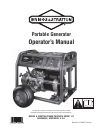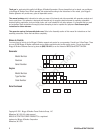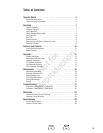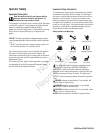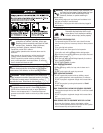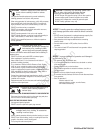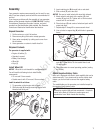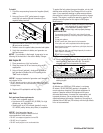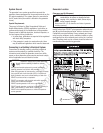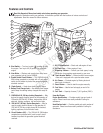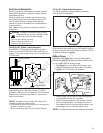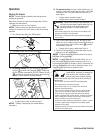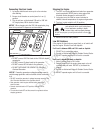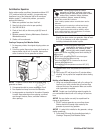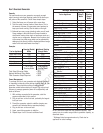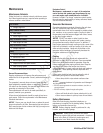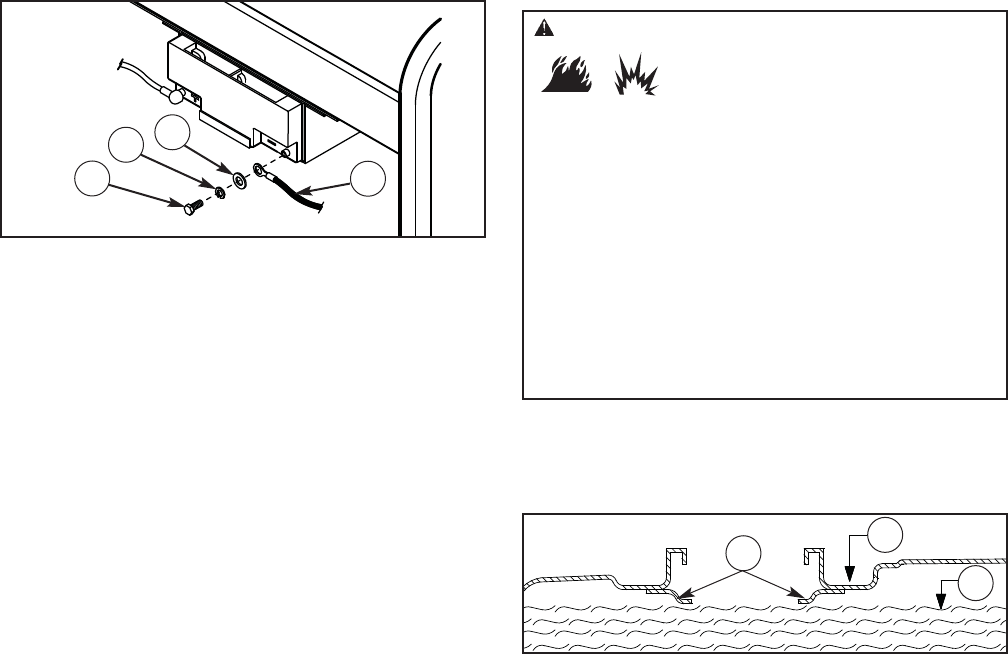
To install:
1. Cut off tie wrap securing loose end of negative (black)
cable.
2. Using an 8 mm or 5/16” socket wrench, remove
screw (A), lock washer (B) and flat washer (C) on
negative battery terminal.
3. Slide lock washer, flat washer and negative battery cable
(D) over screw as shown.
4. Reattach screw to negative battery terminal and tighten.
5. Verify that connections to battery and generator are
tight and secure.
NOTICE If your battery is discharged, charge prior to use
following the instructions in the section Battery Charger.
Add Engine Oil
1. Place generator on a flat, level surface.
2. Clean area around oil fill and remove yellow oil fill
cap/dipstick.
3. Using oil funnel (optional), slowly pour contents of
both provided oil bottles into oil fill opening to the
“Full” mark on dipstick.
NOTICE
Improper treatment of generator could damage it
and shorten its life.
• DO NOT attempt to crank or start the engine before it has been
properly serviced with the recommended oil. This could result in
an engine failure.
4. Replace oil fill cap/dipstick and fully tighten.
Add Fuel
Fuel must meet these requirements:
• Clean, fresh, unleaded gasoline.
• A minimum of 87 octane/87 AKI (91 RON). For high
altitude use, see High Altitude.
• Gasoline with up to 10% ethanol (gasohol) or up to
15% MTBE (methyl tertiary butyl ether) is acceptable.
NOTICE Avoid generator damage.
Failure to follow Operator’s Manual for fuel
recommendations voids warranty.
• DO NOT use unapproved gasoline such as E85.
• DO NOT mix oil in gasoline.
• DO NOT modify engine to run on alternate fuels.
To protect the fuel system from gum formation, mix in a fuel
stabilizer when adding fuel. See Storage. All fuel is not the
same. If you experience starting or performance problems
after using fuel, switch to a different fuel provider or change
brands. This engine is certified to operate on gasoline. The
emission control system for this engine is EM (Engine
Modifications).
1. Clean area around fuel fill cap, remove cap.
2. Slowly add unleaded gasoline (E) to fuel tank (F). Be
careful not to fill above the baffle (G). This allows
adequate space for fuel expansion as shown.
3. Install fuel cap and let any spilled fuel evaporate before
starting engine.
High Altitude
At altitudes over 5,000 feet (1524 meters), a minimum
85 octane / 85 AKI (89 RON) gasoline is acceptable. To
remain emissions compliant, high altitude adjustment is
required. Operation without this adjustment will cause
decreased performance, increased fuel consumption, and
increased emissions. See an authorized dealer for high
altitude adjustment information. Operation of the engine at
altitudes below 2,500 feet (762 meters) with the high altitude
kit is not recommended.
8 BRIGGSandSTRATTON.COM
D
A
B
C
WARNING Fuel and its vapors are extremely flammable
and explosive which could cause burns,
fire or explosion resulting in death,
serious injury and/or property damage.
WHEN ADDING FUEL
• Turn generator engine OFF and let it cool at least 2 minutes
before removing fuel cap. Loosen cap slowly to relieve pressure
in tank.
• Fill fuel tank outdoors.
• DO NOT overfill tank. Allow space for fuel expansion.
• If fuel spills, wait until it evaporates before starting engine.
• Keep fuel away from sparks, open flames, pilot lights, heat, and
other ignition sources.
• Check fuel lines, tank, cap and fittings frequently for cracks or
leaks. Replace if necessary.
• DO NOT light a cigarette or smoke.
FUEL
TANK
G
F
E
Not for
Reproduction



